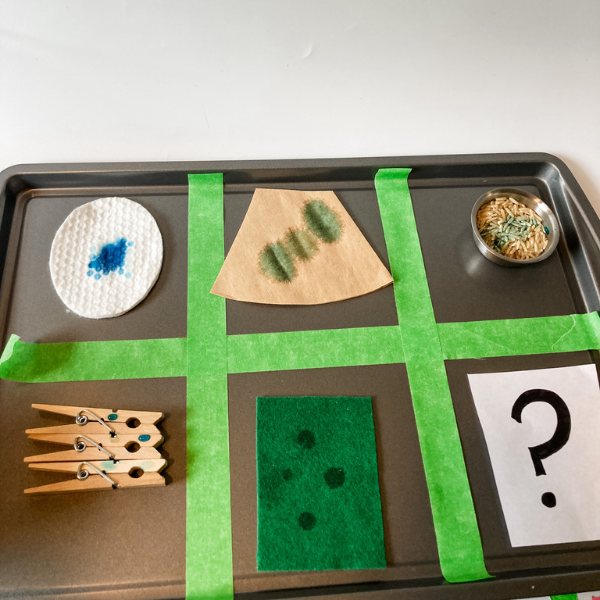
As we talk about the states of water, it’s so much fun to get to do so many sensory activities that also use the language of experimentation. Children are natural little scientists—their curiosity, their questions, their skepticism, their sense of wonder…all are qualities that scientists use in their every day lives as their questions drive them to make discovers and solve some of the world’s biggest quandaries. In this activity, we invite children to test different materials to understand how and why some materials might be more likely to absorb liquids than others.
One important quality of a scientist is to stay organized. They keep detailed notes about the careful observations that they make, and it is important to keep their work area clean and organized. This activity is fun and sensory, but also a great way to teach about grouping and organizing information, using painters tape and a baking sheet.
Set up Time: 10 minutes
Directions
Gather a clean baking sheet and some painters tape. Make clean rows or squares with your painter’s tape—you can narrate out loud that you are doing this so that we can keep track of the results of your experiment, or you can ask children why they think you are doing it. Some of the magic of early childhood is when you make something very simple turn into a whole production—children love to slow down and make everyday things exciting, like turning a baking tray into an experimentation station. Here, we make 6 boxes to compare the absorption of six different materials, but you can always design your tray as it fits your needs!
Absorption Experiment:
- Gather suggested materials to experiment: sponges, paper, cotton pads, dry rice, cloth, Wood, rocks, bricks, dirt, bananas, apples, oranges.
- Add items to your squares, perhaps leaving some squares blank (children can brainstorm about other materials that they might want to add). You can add food coloring to your water to make it easier to see the absorption. Invite children to add one of two drops of water to each material to see if they absorb. Do they absorb right away? Slowly over time? Does the water expand out, or sink in directly?
Materials
- Baking sheet
- Craft tape
- Various items (sponges, paper, cotton pads, etc)
Learning Through Play
Cognitive: Problem-Solving – Educators can encourage scientific thinking by inviting children to make predictions, guesses, or hypotheses about what will happen. First, make sure you teach what the word absorb means, demonstrating with a sponge. A child-friendly definition—saying for example that absorbing means that the liquid, or water, goes inside of the object, it is like it collects it all up. You can invite the children to practice saying the word with you, making sound effects that might accompany the action, and acting out what it would look like if you absorbed water. Then, during the experiment ask children what they observe. Do some materials absorb the water completely? Do some absorb quickly or slowly? Does the water move in a certain direction? Does it remind them of anything?
Language: Vocabulary – Absorb is actually a very useful term to learn in science—plants absorb sunlight and water, the small intestine absorbs nutrients from healthy food, structures can absorb sound, and houses can absorb heat. So, have fun with this activity, iterate on it, and know that you are giving children concrete, kinesthetic understanding of something they will need later in school!
School Readiness: Writes – Extend this by keeping a scientific notebook nearby to record your findings—children can draw pictures of the items, scribble write, or you can record their observations. You can say out loud “I notice how you are really thinking about this from different angles, I am going to write down the things you are saying so that we remember our discoveries.”
See this activity in the Rayz Kidz app along with the other fun art activities. Rayz Kidz is your trusted source for play-based activities featuring over 100 themes and 500+ hands-on activities and clear descriptions of the beautiful learning that is happening through play.